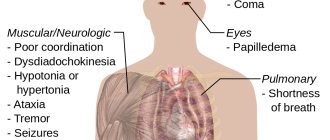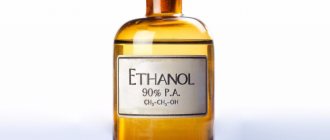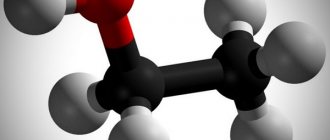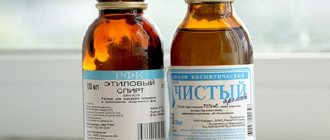Camphor alcohol is made from camphor and 70% ethyl alcohol. The drug is intended for external use and is classified as a local irritant. It is used to improve blood circulation in tissues. Thanks to its pronounced antiseptic and analgesic properties, comfortable alcohol allows you to fight inflammation and pain that occurs during the development of various diseases of the joints and muscles.
Pharmacodynamics and pharmacokinetics
In medicine, the use of camphor alcohol can be very diverse. As you know, it is used as an external agent and for subcutaneous administration. The drug exhibits an antimicrobial effect and helps eliminate pain and inflammation. In addition, a local irritant effect is noted.
When camphor in injections, certain centers of the brain are stimulated. As a result, the drug has a tonic effect, constricts blood vessels or veins, increases blood supply to the brain and heart, and improves breathing.
When camphor is administered subcutaneously, good penetration through the placental barrier is noted, and the substance is also excreted in breast milk.
Excretion from the body occurs mainly through the kidneys, in small quantities - with bile and lungs.
Contraindications
It is strictly forbidden to use an alcohol solution of camphor for the following diseases:
- allergy to the ingredients of the drug;
- open wound, dermatitis or eczema at the site of application of the drug;
- epilepsy;
- age under 12 months.
In addition, it is not recommended to use this drug for self-medication for nursing mothers and pregnant women, since camphor penetrates the placenta and into breast milk.
The attending doctor can prescribe an alcohol solution of camphor only if the expected result is higher than all the risks. But today there are safer means that are not inferior in effectiveness to camphor alcohol.
Indications for use
External use of the drug is recommended for:
- myositis;
- neuralgia;
- carrying out the prevention of bedsores .
Subcutaneous administration of the solution is prescribed for:
- heart failure;
- collapse;
- respiratory depression caused by infections;
- poisoning with sleeping pills or opioid analgesics .
The use of camphor alcohol for joints
- Compress with camphor alcohol. A piece of gauze, folded in 5-6 layers, is soaked in this product and applied for joint pain. Place polyethylene or wax paper on top of the gauze, as well as a layer of cotton wool and secure with a bandage. The compress is left for 2-3 hours. The effect of such treatment will be noticeable literally after the first procedure.
- Rub for joints. To prepare such a medicine, you will need the following ingredients: camphor alcohol (10 ml), Analgin (10 tablets), iodine (10 ml) and 70% ethyl alcohol (250 ml). These ingredients are mixed so that a homogeneous mass is formed. Rubbing the joints is carried out mainly before bed, after which they are wrapped in warm natural fabric. This procedure will help eliminate inflammation and restore joints.
Instructions for camphor alcohol (Method and dosage)
The instructions for use prescribe that this drug can be used in a variety of cases. In this case, the use of camphor alcohol is possible both externally and for subcutaneous administration.
The use of camphor alcohol for bedsores helps prevent the development of complications and necrosis . But it should be used only when the skin is red, as long as there is no violation of its integrity.
The drug is no less actively used in the treatment of inflammatory diseases and so on.
As for the dosage and treatment regimen, all prescriptions are carried out by the attending physician, taking into account the characteristics of the patient and the complexity of the disease.
Indications
Indications for the use of camphor alcohol are diseases that are accompanied by inflammation of joints and muscle tissue. The drug allows you to stabilize the condition in the following pathologies:
- Sciatica. Inflammation of the sciatic nerve is always accompanied by burning pain in the back and decreased muscle strength
- Myositis. Inflammation of skeletal muscles is characterized by acute and muted pain. The chronic form is accompanied by weakening of muscles and limited movement.
- Joint pain. They are a common symptom of musculoskeletal diseases.
- Myalgia. It is characterized by muscle pain of varying intensity. Provoking causes are often stress and nervous tension.
- Arthritis. The inflammatory disease is accompanied by pain with any movement. Additionally, skin redness and hyperemia are observed in the area of the damaged joint.
- Radiculitis. The disease develops when the nerve roots in the intervertebral foramina become inflamed. This leads to severe, debilitating lower back pain.
Camphor alcohol helps with itchy skin. The distracting effect of the drug can reduce discomfort during the treatment process. External use of the product is indicated for bedsores that occur on the skin during prolonged immobilization. After treating damaged areas, it is possible to increase blood circulation and improve oxygen supply to tissues.
Camphor alcohol in the ear
Quite often, the drug is used to treat inflammation in the ears, for example, otitis media .
As a rule, the use of Comfort Alcohol in the ear is allowed in diluted form. For a compress, take a 2% solution, which is diluted by half with water. As a result, pain and swelling are relieved.
In addition, the use of camphor alcohol for the ears is allowed in the form of baths or instillation of a heated product. However, regardless of the method of treating the disease, you must first obtain a doctor’s prescription.
Directions for use for otitis media
- To prepare ear drops from an alcohol solution of camphor, you need to dilute it with chilled boiled water in a 1:1 ratio. Before using even a diluted drug, you should consult your doctor to rule out perforation of the eardrum, as this is an absolute contraindication. The resulting solution is heated to body temperature and instilled into the sore ear 2-3 times a day, 1-3 drops, after which the excess medicine is removed with a cotton swab or turunda.
- To make a compress with camphor alcohol, you will also need to dilute the product with water and heat it to body temperature. After this, a piece of gauze is folded into 5-6 layers, a hole for the ear is cut out, soaked in the solution and placed on the ear so that the auricle is in the hole prepared in advance for it. Wax paper must be placed on top of the gauze, which also has a hole for the ear. The last layer of the compress will be made of cotton wool, on which you can apply a bandage or plaster. A compress on the ear with camphor alcohol is applied for 3-4 hours.
- A tampon with camphor alcohol effectively eliminates the inflammatory process and is an excellent alternative to ear instillation. To do this, a small tampon is formed from a piece of cotton wool, which is soaked in camphor alcohol and lightly wrung out, after which it is placed in the ear canal for 15-20 minutes.
Is it possible to instill camphor alcohol in the ears of children? This question is very often of interest to mothers who have encountered otitis media in children. So let's figure it out.
Since a child’s skin is more delicate and prone to irritation or allergic reactions than that of adults, it is recommended to replace instillation of camphor alcohol in the ears with a compress. Moreover, even a compress on the ears can cause an allergic reaction or irritation, so you need to periodically check the condition of the skin under the bandage.
Camphor alcohol for acne
The anti-inflammatory, antimicrobial and analgesic effects characteristic of this drug can help in the treatment of acne. If you wipe the solution on the affected skin of your face, you can quickly get rid of acne and dry out oily skin.
However, the use of this product in cosmetology is far from safe. It is known to have an irritating effect and stimulate the nerve endings of the skin.
Therefore, camphor alcohol can be used only a few times in diluted form. It can also be used as part of skin masks.
Camphor alcohol: application and pharmacological properties
It has the following pharmacological properties:
- antiseptic;
- anti-inflammatory and wound healing;
- is a local irritant;
- improves circulation processes in tissues;
- acts as a thinning agent on viscous secretions;
- has a cardiotonic effect.
Camphor alcohol has an excellent effect on the constriction of veins and blood vessels , improves blood microcirculation in the heart and brain vessels, expands respiratory functions, is a stimulant of the central nervous system, and accelerates metabolic processes in the heart muscle.
The camphor drug is excreted through the kidneys. In addition, camphor particles can even penetrate the respiratory tract and bile.
Analogs
Level 4 ATX code matches:
Dolobene
Nayatoks
Finalgon
Apizartron
Bee venom
Gavkamen
Dimexide
Menthol oil
Gum turpentine
Capsicam
Tizol
Turpentine ointment
Formic alcohol
Mataren Plus
Dimethyl sulfoxide
Fast Relief
Analogues of the drug include: Camphor granules, Camphor ointment, Camphor solution for injection, Camphor oil.
Is it possible to drink an alcohol solution of camphor?
Camphor alcohol can only be treated externally. If you drink the drug, you can cause poisoning, which is manifested by an accelerated pulse and heartbeat, nervous excitability and convulsions.
As a result, we can say that camphor alcohol is an effective and affordable remedy that will help reduce pain in the ear, joints, back and muscles, as well as get rid of acne on the face and prevent the appearance of bedsores. But you need to remember that the drug has a number of contraindications and side effects, so before treatment you should definitely consult a doctor.
Reviews of Camphor alcohol
Numerous reviews of camphor alcohol confirm the admissibility of its widespread use in medicine.
This remedy is often used for warming compresses in the treatment of lactostasis in nursing women. Although, according to the latest information, its use for this purpose is contraindicated, since such use can disrupt lactation or even stop completely.
In addition, there are often discussions of this remedy in the treatment of acne. On forums, users have heated debates about whether it can help with acne. As it turned out, the effectiveness of the solution appears only at the first stages of treatment, but over time, irritation and worsening of the situation usually develop.
The high effectiveness of camphor alcohol as a prophylactic for bedsores has been noted. At the same time, experts remind that you can use it as long as there are no wounds or abrasions on the skin. If there are already violations of the integrity of the skin, then other drugs must be used.
Undoubtedly, camphor alcohol is one of the most effective and inexpensive means of widespread use. But it can only be used during first aid to disinfect the skin, reduce pain during neuralgia, and ease breathing during a cold. Only the attending physician can prescribe long-term treatment with this drug.
Camphor alcohol
2%
10%
Registration number: Р N003092/01
Trade name: Camphor alcohol.
International nonproprietary or generic name: Camphor.
Dosage form: Alcohol solution for external use.
Composition per 100 ml: Active substance:
- Camphor (synthetic camphor) 2 g or 10 g
Excipient:
- Ethanol (ethyl alcohol) 70% up to 100 ml
Description: Transparent, colorless liquid with a characteristic camphor odor. Pharmacotherapeutic group: local anesthetic of natural origin.
ATX code: M02AX10
Pharmacological action: A drug of natural origin, it has a local irritant, antiseptic, anti-inflammatory and analgesic effect. Stimulates sensitive nerve endings, reflexively improves trophism of organs and tissues.
Pharmacokinetics: When applied to the surface of the skin, it is partially absorbed and undergoes oxidation. Oxidation products combine with glucuronic acid and are excreted by the kidneys. Part of the camphor is excreted unchanged by the lungs and bile.
Indications: Myalgia, myositis, arthralgia, sciatica, prevention of bedsores.
Contraindications: Hypersensitivity to any of the components of the drug, damage to the integrity of the skin or inflammatory skin diseases at the site of intended application (including dermatitis, eczema), pregnancy, lactation, childhood (due to lack of data).
Directions for use: Externally. Myalgia, myositis, arthralgia, sciatica: applied to the skin over the affected area 2 - 3 times a day. Duration of treatment is 7 - 10 days.
Prevention of bedsores: Treat the skin 2 - 3 times a day.
Side effects: Allergic reactions (urticaria), skin irritation, headache, dizziness.
Overdose: Symptoms: Excitement, tachycardia, convulsions.
Treatment: Symptomatic.
Release form: Alcohol solution for external use 2%, 10%. 40 ml in orange glass bottles, sealed with polymer stoppers and screw caps. Each bottle with instructions for use is placed in a cardboard pack. It is allowed to pack bottles with an equal number of instructions for medical use in a group package. 4 kg, 8 kg in polyethylene canisters; 18 kg in polyethylene canisters or glass bottles (for hospitals).
Storage conditions: Protected from light at a temperature of 15 to 25°C. Keep out of the reach of children.
Shelf life: 3 years. Do not use after expiration date.
Conditions for dispensing from pharmacies: Without a prescription.








